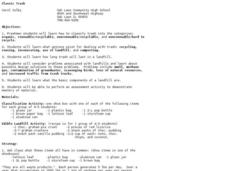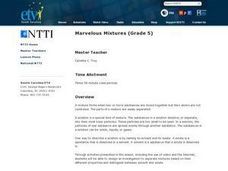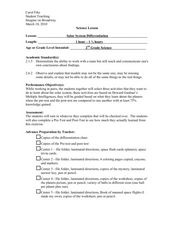Curated OER
Minerals
Learners apply rules to compare and rank the hardness and softness of minerals. They perform a scratch test on four unknown mineral samples, read a bar graph that illustrates the comparative hardness and softness of four named minerals,...
Curated OER
Diffusion
Students design and carry out an experiment according to the scientific method. The experiment must test the effects of time and concentration on the rate of diffusion of potassium permanganate into potato cubes. After performing the...
Curated OER
Personal Development - Setting Goals to Achieve Objectives
Students explore reasons for setting goals and techniques to achieve them. They discover the importance of setting goals, both short-range and long-range. Students assess their own situation and write specific goals to meet their...
Curated OER
Clouds
Second graders explain what a cloud is, how it is formed and what the various types of clouds are. They do an experiment which shows them how to "make" a cloud, and write in their science journals about a "crazy weather day."
Curated OER
That's Dope - Part 1
Students investigate drugs in sports. In this performance enhancing drugs lesson, students discuss the uses for steroids in medicine and sports. Students utilize the web to play a steroid related game, view media clips of their favorite...
Curated OER
Moon
Students discover scientific facts about the Moon and how
some American Indian Tribes used the moon to measure time.
They accomplish this by listening to stories and poetry, writing
stories, communicating with an astronaut,...
Curated OER
The First Fire : A Cherokee Animal Tale
Fourth graders discover movement through the telling of "The First Fire", a Cherokee tale. Small groups are given sections of the story to tell by creating dances. Music (live and recorded) adds to the final performance and assessment.
Curated OER
World Population Activity II: Excel
Students import UNEP World population data/projections from either the World Population Prospects: The 2002 Revision Population Database - UN Population Division or a text file. They graph this data by itself, and then along with...
Curated OER
Classic Trash
Students investigate how trash is classified and the options to deal with it. In this trash and recycling instructional activity, students perform an activity to classify trash into organic, renewable/ recyclable, now...
Curated OER
Conduction, Convection and Radiation
Sixth graders listen to descriptions of types of heat to gain background knowledge In this heat lesson, 6th graders perform experiments to understand various types of heat transfer (convection, conduction and radiation.) Students assess...
Curated OER
Volcanoes
Third graders study the concept of plate tectonics. In the process they embark in research and construction of a volcano. They complete a web quest while assessing how to research, give oral reports, and create a product.
Curated OER
Sound for Sight
Students study echolocation and understand how dolphins use it to locate prey, escape predators, and navigate their environment. They view a video, "In the Wild-Dolphins with Robin Williams" and see first hand how dolphins communicate. ...
Curated OER
Stoichiometry
Young scholars discover stoichiometric relationships in chemical equations. They review mole to mole conversions. They understand mass/particle conversions. They perform a lab to reinforce stoichiometry.
Curated OER
Heat Energy
Young scholars study how matter changes from solids to liquids or liquids to solids. In this physical science instructional activity, students discuss heat energy and experiment with heat by changing a candle into a liquid using a hot...
Curated OER
NJ HSPA Cluster 4
Pupils engage in a lesson that is focused upon helping them to complete exercises used to prepare for the High School Proficiency Assessment. They look at the patterns seen in algebraic problems and focus upon the cluster areas of...
Curated OER
Marvelous Mixtures
Fifth graders design an experiment in which they separate mixtures. In this mixtures lesson plan, 5th graders define mixtures, solutions, solutes, and solvents. They watch a video, complete worksheets, and perform an experiment to...
Curated OER
Solar System Differentiation
Students explore the solar system. In this solar system science instructional activity, students choose 3 out of 12 centers to visit, each of which contains an activity related to the planets. The station activities are designed to...
Curated OER
Concrete Research
Students explore concrete. In this physical science and computer research instructional activity, students work in groups to answer specific questions about concrete. Each group of students completes a different worksheet with a...
Curated OER
Plant Needs
Students explore the needs of plants. In this plants biology lesson, students work in groups to perform an experiment with tomato plants. Each group records observations in a journal, takes pictures, and interprets the results of...
Curated OER
Biology: Cells and Chemical Changes
Students explore the numerous functions of cells in both plants and animals. Following a pre-assessment, they construct cell models and examine onion cell slides stained with iodine or dye. After participating in experiments on how to...
Curated OER
Diatoms of Laboratory Indicators of Water Quality
In this science worksheet, high schoolers use the diatoms present in water in order to test water quality and perform data collection and interpretation.
Curated OER
The Bending and Bouncing of Light
Students investigate refraction and reflection of light. In this light lesson, students perform 3 activities to observe light interacting with matter by using a flashlight. They explore refraction using a glass of water and reflection...
Curated OER
Pollution in the Air and the Water Pollution Solution
Students explore air pollution. In this ecology and air pollution instructional activity, students perform an experiment in which a Vaseline coated lid is placed inside and outside the classroom. Students make predictions and then record...
Curated OER
Plants vs. Animals
Students discuss the differences they can see between examples of animals and plants. In this science instructional activity, students draw or write what they have discussed about the examples. Students go on a nature walk to look...

























